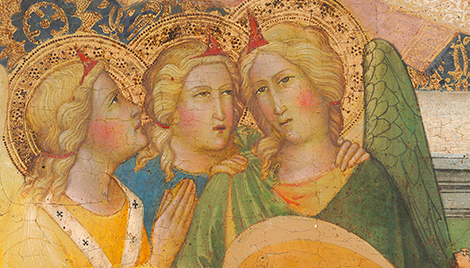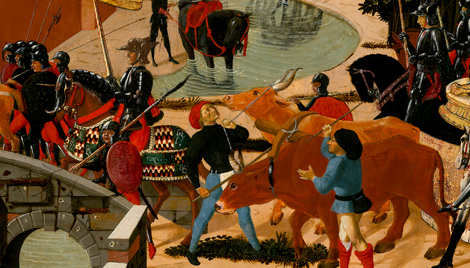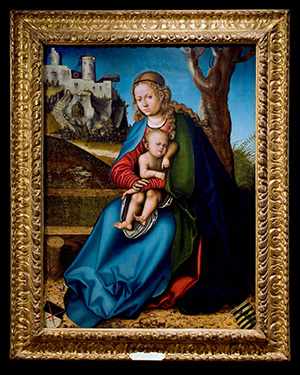Virgin and Child
Virgin and Child
- Artist
- Lucas Cranach the Elder
- Artist Dates
- 1472-1553
- Artist Nationality
- German
- Title
- Virgin and Child
- Date
- 1513-14
- Medium
- oil on lime
- Dimensions
- 121.9 x 90.9 cm (48 x 35-3/4 in)
- K Number
- K1595
- Repository
- University of Arizona Museum of Art
- Accession Number
- 1961.013.004
- Notes
Provenance
Originallly commissioned by Frederick III, known as the Wise, Elector of Saxony [1463-1525; his coats of arms at lower left and lower right). Maximilian Freiherr von Heyl [1844-1925], Darmstadt, by 1899 and still in 1904. [1] Frau Direktor Albert Ullman by 1925. [2] (Paul Drey, New York) from 1940; [3] sold to Samuel H. Kress [1863-1955] in 1948; gift to University of Arizona Museum of Art in 1961, no. 1961.013.004. [1] Exhibited in Cranach Ausstelllung, Dresden, 1899, no.116 and in Kunsthistorische Ausstellung, Dusseldorf, 1904, no. 214. [2] Exhibited in Städelschen Kunstinstitut, Frankfurt, Ausstellung von Meisterwerken alter Malerei aus Privatbesitz, Summer 1925, no. 40. [3] Exhibited Kansas City, Missouri, William Rockhill Nelson Gallery, Seventh Anniversary Exhibition of German, Flemish, and Dutch Painting, 1940-41, no. 12.
Catalogue Entry
Lucas Cranach the Elder
Virgin and Child
K1595
Columbia, Mo., University of Missouri, Study Collection (61.82), since 1961.(1) Canvas. 18 1/8 x 15 1/4 in. (46.4 x 38.8 cm.). Good condition. The stylistic conformity of K1590 to Rotari's many paintings of similar subjects dating from his years at the court of St. Petersburg (1756-62) leaves no doubt about the attribution and approximate date of K1590.(2) It may be noted also that the X-ray of K1590 shows the same thin application of paint to a closely woven canvas that X-rays of other Rotari paintings show. K1590 may well be the most popular of the hundreds of heads painted by Rotari. It is known in many versions, some painted by Rotari himself or by close Italian followers and some by French artists of the period, sometimes identified as Boucher.(3) Heads similar to Rotari's were indeed a favorite subject of Boucher's during the 1750s and 1760s. They are most frequent among his drawings and pastels.(4) But the two artists were very different in their approach to the subject. An intimate coquetry is suggested in Rotari's portrayal; he likes to show his model looking coyly at the spectator, establishing an immediate contact. In contrast, Boucher's heads look in another direction; theirs is an objective charm. The invention of the composition of K1590 would seem to be more likely Rotari's than Boucher's. K1590 and some of its other versions are sometimes entitled Portrait of the Artist's Wife, but I find no evidence for the identification. K1590 is the only version I know which shows the young woman leaning against the back of a chair (an eighteenth-century type, with carved, round-arched frame) instead of a pillow. It may be noted that the sprig of jasmine tucked casually into her bodice becomes a conspicuous full-blown rose in the French versions. Provenance: Catherine II, Empress of Russia, St. Petersburg (presumably painted for the Gallery of Graces, Peterhof Palace, near Leningrad). Paul Drey's, New York –exhibited: 'Four Centuries of Venetian Painting,' Toledo Museum of Art, Toledo, Ohio, Mar. 1940, no. 43 of catalogue by H. Tietze, as Rotari; 'Italian Baroque Painting,' California Palace of the Legion of Honor, San Francisco, May 16-June 15, 1941, no. 100 of catalogue by T. C. Howe, Jr., as Rotari. Kress acquisition, 1948.
References
(1) Missouri Alumnus, May 1961, p. 4, as Rotari. (2) K1590 has been attributed to Rotari by G. Fiocco, A. Venturi (in ms. opinions), and H. Tietze (loc. cit. in Provenance). (3) Because of the little-understood relationship between the style of heads painted by Rotari and his followers and the style of those painted by Boucher and his followers, it seems worth while to cite the considerable number of known versions of K1590. Whether Boucher or Rotari set the fashion for painting these fanciful heads it may be impossible to decide. Certainly Rotari painted a far greater number of them than did Boucher, and Rotari's must have been well known in France. The version which should be mentioned first, perhaps, because it also is in the Kress Collection, is the French pastel on the central door of an eighteenth-century secretary now at the Metropolitan Museum, New York (cat. no. 58.75.120). This pastel is discussed and reproduced by J. Parker, in Decorative Art from the Samuel H. Kress Collection, 1964, pp. 96 f., figs. 82, 85, where the following versions of Rotari's painting are cited: (a) a pastel now in the Pushkin Art Museum, Moscow, attributed by A. Benois (in Art Treasures in Russia, vol. V, 1905, fig. 64) to Boucher; (b) a pastel attributed to a French artist in the Art Gallery of Western Australia, Perth; (c) an oil attributed to Rotari, from a series painted for Schloss Pillnitz on the Elbe, sold from the H. M. Gutmann Collection, at Paul Graupe's, Berlin, Apr. 12-14, 1934, no. 31; (d) an oil at Archangelskoye, former Yussupov estate near Moscow; (e) a painting attributed to Rotari in the A. Seligmann Collection, New York (G. Fiocco, in Emporium, vol. XCVI, no. 571, 1942, p. 278); (f) an oil attributed to Rotari in the Cummer Gallery of Art, Jacksonville, Fla. (reproduced, p. 58 of 1961 catalogue of the gallery); (g) a version shown hanging on the wall of a room in an etching by Daniel Chodowiecki (1726-1801), entitled 'Cabinet d'un Peintre' (portfolio of Chodowiecki's etchings, Metropolitan Museum, no. 23.74; reproduced by G. Calov, in Museums Kunde, vol. XXXVIII, 1969, p. 47, fig. 11). To the above list of versions may be added an enamel miniature 'of the artist's mother, by Joseph Lee,' on a tortoise-shell-and-gold snuffbox, sold at Sotheby's, London, Dec. 15, 1969, no. 41 of catalogue, reproduced; an oil from a set of four attributed to Rotari, sold at Sotheby's, London, July 10, 1968, no. 77 of catalogue, reproduced; an oil attributed to Rotari in the Walters Art Gallery, Baltimore, Md.; a pastel which looks very similar to the one at the Metropolitan, and is attributed to Boucher, no. 359 in a sale at R. Lepke's Auction House, Berlin, Nov. 6-7, 1928, with a pendant Girl Asleep; and, finally, another pastel attributed to Boucher, sold in Paris, June 2, 1913, as no. 112 from the collection of Eugène Kraemer, this also with a pendant Girl Asleep. Significantly, this last pastel version of K1590 is reproduced by G. Wildenstein (in Gazette des Beaux-Arts, vol. LVIII, 1961, p. 67, fig. 25) as a copy of a pastel by Boucher in the collection of Jacques Onésyme (Vente Bergeret 137). Bergeret should be trusted to know his Bouchers; but is the Kraemer pastel certainly after Bergeret's Boucher? (4) Cf. A. Ananoff, L'Oeuvre dessiné de Francois Boucher, 1966, figs. 61 ff.
Catalogue Volume
Italian Paintings XVI – XVIII Century






